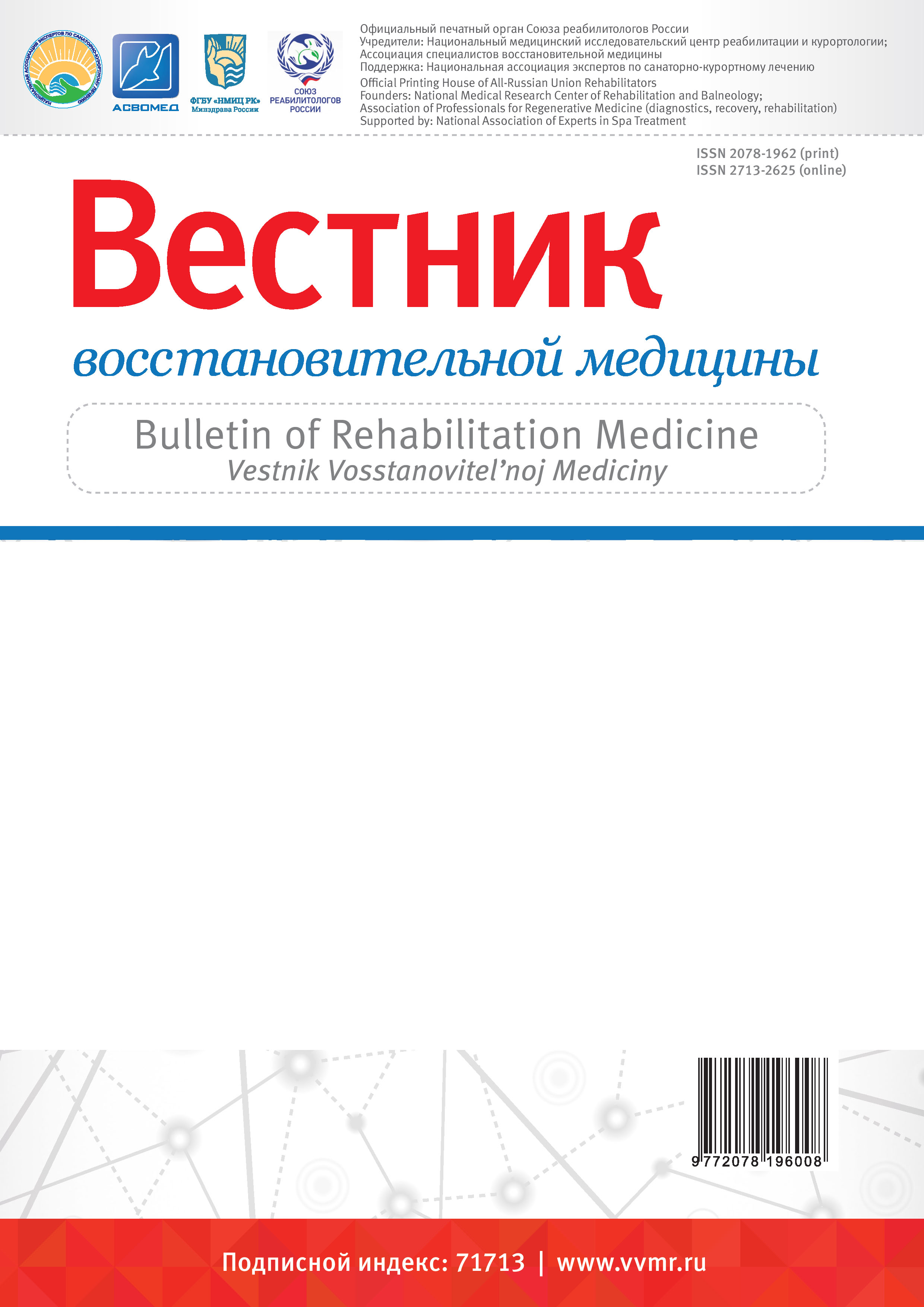Кубанский государственный медицинский университет Минздрава России, Краснодар, Россия
Enhanced external counterpulsation (EECP) has taken a worthy place among other methods in the complex treatment and rehabilitation of patients with cardiovascular pathology. Its use in outpatient and sanatorium-clinical practice significantly expands the prospect of treatment and improvement of prognosis in a wide range of patients with multifocal atherosclerosis. Aim. To study the effect of the EECP method in the complex medical rehabilitation of stable forms of coronary heart disease (CHD) in patients permanently residing in the resort city of Sochi. Material and methods. The study included 60 patients with CHD (FC II – 23, FC III – 29, FC IV – 8) living in the resort city of Sochi. Patients were randomized into intervention and control groups, in which there were no significant differences between clinical and anthropometric parameters. All of them received basic drug therapy, a complex of climatotherapeutic non-drug effects and attended the Coronary Club, a public health school for patients with CHD. Additional outpatient courses of EECP were conducted in the form of 35 one-hour sessions daily, 5 days a week, a full course for 7 weeks for each patient of the intervention group on basis. Initially and after the end of the rehabilitation course, the patients of both groups underwent electrocardiography (ECG), bifunctional daily ECG and blood pressure monitoring, Doppler echocardiography, ultrasound duplex scanning of brachycephalic vessels and lower limb vessels, exercise test on cycle ergometer, six-minute walking test, as well as physical activity level determination using IPAQ questionnaire and psychodiagnostic testing. Results and discussion. When comparing the data, patients in the intervention group showed a significant reduction in angina attacks and nitroglycerine use, stabilization of central haemodynamic parameters, increased exercise tolerance and improved subjective “quality of life” indicators. Conclusion. The data obtained confirm the experience accumulated in the world medical practice of the effective clinical impact of the EECP method in the treatment of patients with chronic coronary syndromes in outpatient treatment, including in conditions of humid subtropical climate. Therefore, its inclusion in the programs of complex sanatorium-resort rehabilitation of patients with stable forms of CHD is justified and promising.
enhanced external counterpulsation, coronary heart disease, humid subtropics, medical rehabilitation
1. Vershinin A.A., Kolesnikova E.A., Belyaeva I.A., Martynov M.Yu., Gusev E.I., Melent'ev A.S. Vozmozhnosti kolichestvennoy ocenki funkcional'nyh rezervov-serdechno-sosudistoy sistemy v profilakticheskoy i reabilitacionnoy medicine. Doktor RU. Nevrologiya i psihiatriya. 2014; 6(94): 10-14.
2. Vladimirskiy V.E, Vladimirskiy E.V, Lunina A.N., Fesyun A.D., Rachin A.P., Lebedeva O.D., Yakovlev M.Yu. Znachenie fizicheskih nagruzok v reabilitacii bol'nyh serdechno-sosudistymi zabolevaniyami. Vestnik vosstanovitel'noy mediciny. 2021; (3): 16-25. https://doi.org/10.38025/2078-1962-2021-20-3-16-25
3. Saunders D.H., Sanderson M., Hayes S., Johnson L., Kramer S., Carter D.D., Jarvis H., Brazzelli M., Mead G.E. et al. Physical fitness training for stroke patients. Cochrane Database of Systematic Reviews. 2020; 3(3). https://doi.org/10.1002/14651858.CD003316.pub7
4. Barry A.F., Thompson P.D., Al-Zaiti S.S., M.A. Christine, Hivert M., Levine B.D. Exercise-related acute cardiovascular events and potential deleterious adaptations following long-term exercise training: placing the risks into perspective - an update: A Scientific Statement from the American Heart Association. Circulation. 2020; 141(13): 705-736. https://doi.org/10.1161/CIR.0000000000000749
5. Myers J., Kokkinos P., Narayan P. Physical Activity, Cardiorespiratory Fitness, and the Metabolic Syndrome. Nutrients. 2019; 11(7): 1652 p. https://doi.org/10.3390/nu11071652
6. Hornnes N., Larsen K., Boysen G. Little change of modifiable risk factors 1 year after stroke: a pilot study. International Journal of Stroke. 2010; (5): 157-162.
7. Billinger S., Arena R., Bernhardt J. et al. Physical Activity and Exercise Recommendations for Stroke Survivors A Statement for Healthcare Professionals from the American Heart Association/American Stroke Association. Stroke. 2014; 45(8): 2532-53. https://doi.org/10.1161/STR.0000000000000022
8. Boyne P., Welge J., Kissela B., Dunning K. Factors influencing the efficacy of aerobic exercise for improving fitness and walking capacity after stroke: a meta-analysis with metaregression. Archives of Physical Medicine and Rehabilitation. 2017; 98(3): 581-95. https://doi.org/10.1016/j.apmr.2016.08.484
9. Blokland I.J., Jmker T., Houdijk H. Aerobic capacity and load of activities of daily living after stroke. Handbook of Human Motion. Springer. 2017; 2(3): 863-884.
10. Macko R.F., Smith G.V., Dobrovolny C.L., Sorkin J.D., Goldberg A.P., Silver K.H. Treadmill training improves fitness reserve in chronic stroke patients. Archives of Physical Medicine and Rehabilitation. 2001; 82(7): 879-84. https://doi.org/10.1053/apmr.2001.23853
11. Beyaert S., Vasa R., Frykberg G.E. Gait post-stroke: Pathophysiology andrehabilitation strategies. Neurophysiologie. Clinical Neurophysiology. 2015; 45(4-5): 335-355. https://doi.org/10.1016/j.neucli.2015.09.005
12. Lavie C.J., Lee D., Ortega F.B. UK Biobank Contributes to Aerobic and Muscle Fitness Research. Mayo Clinic Proceedings. 2020; 95(5): 840-842. https://doi.org/10.1016/j.mayocp.2020.03.019
13. Anderson L., Oldridge N., Thompson D.R., Zwisler A.D., Rees K., Martin N., et al. Exercise-based cardiac rehabilitation for coronary heart disease: Cochrane systematic review and meta-analysis. Journal of the American College of Cardiology. 2016; 67(1): 1-12. https://doi.org/10.1016/j.jacc.2015.10.044
14. Morris J., Oliver T., Kroll T., Macgillivray S. The importance of psychological and social factors in influencing the uptake and maintenance of physical activity after stroke: a structured review of the empirical literature. Stroke Research and Treatment. 2012; (2012): 195249 p. https://doi.org/10.1155/2012/195249
15. Lennon O., Carey A., GaMney N., Stephenson J., Blake C. A pilot randomized controlled trial to evaluate the benefit of the cardiac rehabilitation paradigm for the non-acute ischaemic stroke population. Clinical Rehabilitation. 2008; 22(2): 125-33. https://doi.org/10.1177/0269215507081580
16. Graven C., Brock K., Hill K., Joubert L. Are rehabilitation and/or care coordination interventions delivered in the community effective in reducing depression, facilitating participation and improving quality of life after stroke? Disability and Rehabilitation. 2011; 33(17-18): 1501-20. https://doi.org/10.3109/09638288.2010.542874
17. Pang M.Y., Eng J.J., Dawson A.S., McKay H.A., Harris J.E. A community-based fitness and mobility exercise program for older adults with chronic stroke: a randomized, controlled trial. Journal of the American Geriatrics Society. 2005; (53): 1667-1674. https://doi.org/10.1111/j.1532-5415.2005.53521.x
18. Shephard R.J. Maximal oxygen intake and independence in old age. British Journal of Sports Medicine. 2009; (43): 342-346. https://doi.org/10.1136/bjsm.2007.044800
19. Jarvis H.L., Brown S.J., Price M. et el. Return to Employment After Stroke in Young Adults. How Important Is the Speed and Energy Cost of Walking? Stroke. 2019; 50(11): 3198-3204. https://doi.org/10.1161/STROKEAHA.119.025614
20. Vanhees L., De Sutter J., Geladas N., Doyle F., Prescott E. Importance of characteristics and modalities of physical activity and exercise in defining the benefits to cardiovascular health within the general population: recommendations from the EACPR (Part I). European Journal of Preventive Cardiology. 2012; 19(4): 670-686. https://doi.org/10.1177/2047487312437059
21. Winstein C.J., Stein J., Arena R. et el. Guidelines for Adult Stroke Rehabilitation and Recovery: a guideline for healthcare professionals from the American Heart Association/American Stroke Association. Stroke. 2016; 47(6): 98-169. https://doi.org/10.1161/STR.0000000000000098
22. Mezzania A., Agostonib P., Cohen-Solald A. Standards for the use of cardiopulmonary exercise testing for the functional evaluation of cardiac patients: a report from the Exercise Physiology Section of the European Association for Cardiovascular Prevention and Rehabilitation. European Journal of Cardiovascular Prevention and Rehabilitation. 2009; 16(3): 249-265. https://doi.org/10.1097/HJR.0b013e32832914c8
23. Balady G.J., Arena R., Sietsem K. et al. Clinician’s Guide to Cardiopulmonary Exercise Testing in Adults. A Scientific Statement from the American Heart Association. Circulation. 2010; (122): 191-225. https://doi.org/10.1161/CIR.0b013e3181e52e69
24. Pandey A., Patel M.R., Willis B., Gao A. et al. Association between midlife cardiorespiratory fitness and risk of stroke: the Cooper Center Longitudinal Study. Stroke. 2016; 47(7):1720-6. https://doi.org/10.1161/STROKEAHA.115.011532
25. Veerbeek J.M., Koolstra M., Ket J.C., van Wegen E.E., Kwakkel G. Effects of augmented exercise therapy on outcome of gait and gait-related activities in the first 6 months after stroke: a meta-analysis. Stroke. 2011; (42): 3311-3315. https://doi.org/10.1161/STROKEAHA.111.623819
26. Austin M.W., Ploughman M, Glynn L, Corbet D. Aerobic Exercise Effects on Neuroprotection and Brain Repair Following Stroke: A Systematic Review and Perspective. Neuroscience Research. 2014; (87): 8-15. https://doi.org/10.1016/j.neures.2014.06.007
27. Constans A., Pinbarre C., Temprado J., Decherchi P., Laurin J. Influence of Aerobic Training and Combinations of Interventions on Cognition and Neuroplasticity after Stroke. Frontiers in Aging Neuroscience. 2016; 30(8): 164 p. https://doi.org/10.3389/fnagi.2016.00164
28. Pollock A., Baer G., Campbell P., Choo P.L., Forster A. et al. Physical rehabilitation approaches for the recovery of function and mobility following stroke. Cochrane Database of Systematic Reviews. 2014; (4). https://doi.org/10.1002/14651858.CD001920.pub3
29. Ivey F.M., Ryan A.S., Hafer-Macko C.E., Macko R.F. Improved cerebral vasomotor reactivity after exercise training in hemiparetic stroke survivors. Stroke. 2011; 42(7): 1994-2000. https://doi.org/10.1161/STROKEAHA.110.607879






